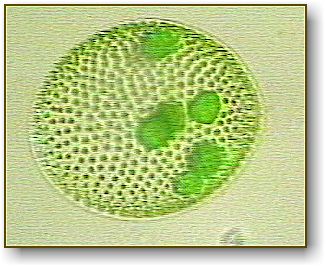By Alissa, Emily, Logan, and Andrew

Description: This is a picture of a single VolvOx colony (magnified), floating through the water.
Image copyright: www.google.com
VolvOx are very interesting to study. When looked at under a microscope, or even by the naked eye, you can see that they are a greenish color and a round shape. These cells are algae. Algae are simple plant organisms found in all wet environments. The VolvOx live in moist places such as rivers, lakes, or oceans. VolvOx live in colonies that contain over 500 cells. The colonies contain daughter cells, and sometimes even granddaughter cells also. After awhile, the daughter cells split from the VolvOx, and create their own colonies. Since the colonies are about 1 millimeter long, they are easily visible to the naked eye. Their enemy is the rotifer. Rotifers are multi-celled animals. Because they are so small, most people have never heard of their existence. VolvOx have tails called flagella, (fleh-gell-uh) that help them move through the water.
Volvox are very interesting things to look at through a microscope. They are green and bold as in round. They move by spinning in the water. One thing I didnít know was that the volvox have a whip like tail that helps them move in the water. The individual cells within the Volvox colony are round and feature a pair of flagella. People would never imagine how the volvox is kind of like us in many ways. For example what they eat. They eat apples.
The volvox eat algae, algae live in water and come in many shapes and sizes. They are shades of green, golden brown, red, or brown. Volvox is always careful around rotifers. The volvox also eats many different kinds of plants. The volvox like the heat of the sun you canít find them on the ground because they are microscopic.
A volvox is very fast. It shifts through the water using its flagella, facing downwards towards the bottom of the water. The only way to observe all this action is to get outside to a pond and bring back some pond water. Then you can take a look under a microscope.
